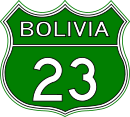Ruta 23 (Bolivia)
| Ruta 23 in Bolivia | ||||||||||||||||||||||||||||||||||||||||

|
||||||||||||||||||||||||||||||||||||||||
| Basic data | ||||||||||||||||||||||||||||||||||||||||
| Operator: | Administradora Boliviana de Carreteras |
|||||||||||||||||||||||||||||||||||||||
| Overall length: | 147 km | |||||||||||||||||||||||||||||||||||||||
|
Course of the road
|
||||||||||||||||||||||||||||||||||||||||
The Ruta 23 is a national road in the South American Andean state of Bolivia .
Routing
The road has a length of 147 kilometers and crosses the southern part of the Departamento Cochabamba from southeast to northwest. The road begins in the town of Aiquile at the intersection with Ruta 5 and leads through the deeply cut valleys between the Cordillera Oriental and the Cordillera Central in a north-westerly direction. The Ruta 23 ends at Paracaya at the Ruta 7 , of Cochabamba to the lowland city of Santa Cruz leads.
The Ruta 23 is completely paved.
history
Ruta 23 was declared part of the Bolivian national road network " Red Vial Fundamental " by law 1861 of July 3, 1998 .
Sections of the route in the department of Cochabamba
Province of Campero
- km 000: Aiquile
Mizque Province
Arani Province
- km 138: Arani